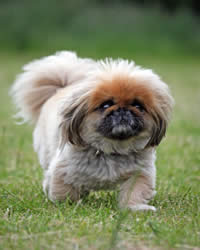Pekingese Dogs – Breed Information
 |
| ||||||||||||||||||||||||||||||||||||||||||||||||||||||||||||||||||||||||||||||||
Pekingese Dogs – Just The Facts
| Do you own this Dog breed?Please tell us about it in the form at the bottom of this page. |
General Description
Some people prefer to call the Pekingese Dogs “Peke” – a moniker for a breed that expects you to lavish it with attention and pampering. The dogs can be somewhat haughty, independent and brave despite their cute size. Since they don’t move around much, they make wonderful companions for couch potatoes, condo dwellers, elderly pet owners and people with disabilities.
Origin and History
You will find glimpses of the canine in many revered 8th century Chinese art pieces. Beijing’s old name – Peking – inspired the breed’s nomenclature. From 1,000 A.D. and earlier, Pekingese Dogs were simply known as lion dogs for they were bred to look like lions. They were also called sleeve dogs because they were often seen clinging to the sleeves of their masters.
In 1860, the Chinese Imperial Palace fell to the hands of the British, and the tiny Pekingese puppies were taken to England where they gained the admiration of Queen Victoria and the rest of the elite community. Today’s Pekingese is no longer just for the affluent but also for the modern pet lover who wishes to own a show dog and an adorable companion in one package.
Pekingese Dogs Temperament
Pekingese puppies act as if they are royalty. Almost always, you’ll find the pooch plopped on the sofa or on a favorite pillow. The dogs are quite polite to strangers and civil to other pets. They despise being rough-handled and scolded, and are best suited to homes without toddlers.
This dog breed’s playfulness will surprise you at times. Despite its devotion to you, the Peke – like a true aristocrat – rarely displays cutesy or sentimental behavior, tending rather to remain poised, if not a bit distant.
Care, Grooming, Diet & Exercise
Living Environment – These tiny dogs don’t have huge space requirements and can fare pretty well in homes without yards. Tailored for luxurious condo and apartment life, Pekingese dogs are intolerant of the heat and are meant to sleep indoors. You should definitely have a reliable air conditioner on hand if you decide to raise Pekingese puppies.
Grooming – Pekingese dogs are one of the more demanding breeds when it comes to grooming. The dogs are heavy shedders. At the minimum, their coat should be brushed daily to twice a week to prevent tangles.
In addition, there are several checks that form part of the breed’s daily ritual: nose cleaning to avoid infections, anal hair inspection to curb soiling, and facial wiping. You should also prepare to cough up some cash for regular dry shampooing.
Diet & Exercise – Feeding Pekingese dogs is a commitment to preparing the meals by yourself. Commercial diets are not optimal for these dogs, who require lean meat and some fresh vegetables and fruits. A natural diet helps to keep the Peke’s gassiness at bay.
Like many among small dog breeds, exercise requirements for the Peke are minimal. Occasional walks are fine to prevent obesity. However, make sure that you don’t let the pooch spend too much time outside – even with your supervision. The breed cannot adjust to weather changes and can die easily from heatstroke or extreme cold.
Health – Twelve to 15 years is quite an impressive lifespan for a breed that’s delicate. Pekingese dogs are generally prone to back problems, breathing difficulties, corneal abrasions and flatulence. To top things, the dogs are extremely sensitive to anesthesia but can’t give birth to pups without caesarian intervention.
Pekingese Dogs Trainability
Dog training and housebreaking Pekingese puppies is a huge challenge. Several factors account for the near impossibility of controlling the puffed-up and obstinate breed. One is the Peke’s stoic nature. Another is its history of royal treatment. Its sensitivity to verbal and physical methods is also a critical factor.
On the bright side, if Pekingese dogs really adore you, they will not play hard to get. In fact, they can choose to be well-tempered without any formal training at all. Go figure.
Do you own this dog breed?
Please tell us about your experience with a particular dog breed, and upload a picture if you have one!
What Other Visitors Have Said
Click below to see contributions from other visitors to this page...
Training my Pekingese dog Romeo 




I just got a Pekingese dog named Romeo. I've only had him for about 3 days and oh boy is he a tough one!
It is so hard to house train him but what …
Tobie 




My fiance and I adopted Tobie in 2008 from Peke N Chin, a rescue organization in the Midwest focused on Pekingese and Japanese Chin dogs. His owner …
Cookie 




We adopted Cookie from the SPCA, he was a rescue dog (he had been thrown out as garbage and left in a bin to die) and as we had previously owned a Pekingnese …
Exceptions to everything Not rated yet
This article is fairly accurate, just that there's a Peke out there that's an exception to everything written here.
If you think you want a Pekingese …
Return to AKC List of Dog Breeds ranked by Popularity
Return from Pekingese Dogs back to Alphabetical List of Dogs Breeds page
Return to Dogs and Dog Advice home